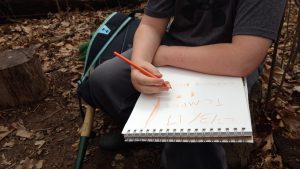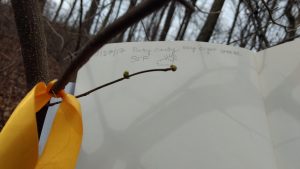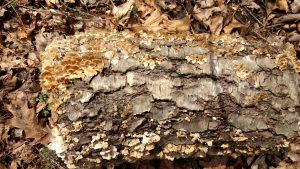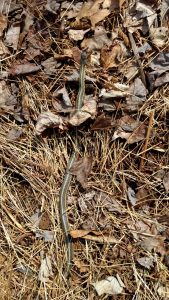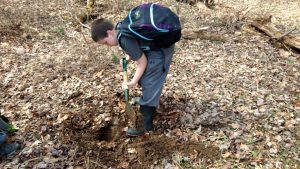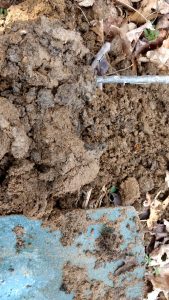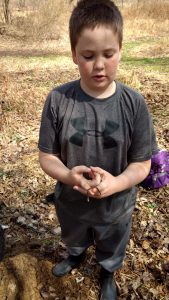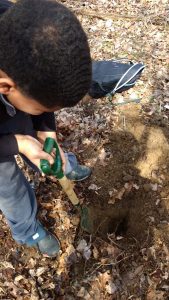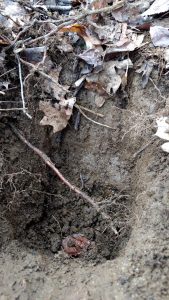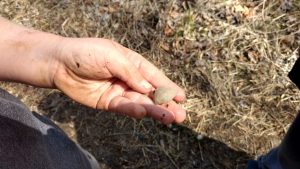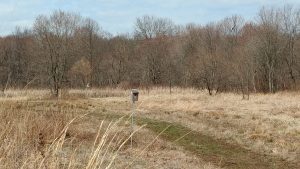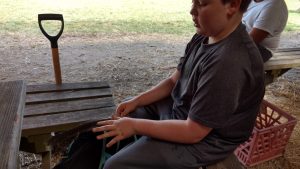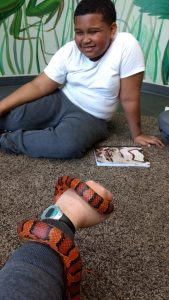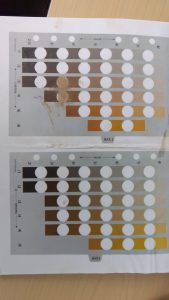Today was a beautiful day to enjoy outside! We started with our weekly phenology study. Again, not much has changed (however, with the warmer weather I think that will change very soon!). Solace got a chance to see his plant after not seeing it last week and did mention that it looked different. The buds were slightly bigger and a more brown color. Interesting! On our way out of our afternoon meeting circle, Solace pointed out a small log covered in fungi! We briefly discussed how this log is starting to decompose and fungus really helps that along. Fungus is a decomposer, just like we learned when we talked about food chains (Check out the log below).
Next we hiked down to the cattails, looking for a good spot to do our first soil sample! You don’t need much to take a soil sample, in fact, you hardly need a shovel, but in order to get a good look at the soil layers, a shovel is helpful (if you want to do actual wetland soil sampling, a sharpshooter shovel is used or a soil corer). Before we found our ideal digging spot (we wanted a “forest” sample so not in the wetlands but close to the cattails because that is where the next sample is coming from!) we found a really awesome garter snake, just basking away in the sun just off the trail in the cut grass. It was just over a foot long and was holding his head up in the air. It barely budged as we watched it. Check it out!!
Garter snakes are a native reptile to the east coast (and Maryland of course) and you can find them throughout most of the US. They come in slight color variations but for the most part are a yellow/brown/green/gray color and almost always have stripes that go down the length of their bodies. Like all reptiles, they are cold blooded and rely on the sun to heat them up. A snake this size preys on small mammals like voles and small field mice but will also eat frogs and other amphibians, fish and even insects. We only used our eyes to observe this amazing animal and it casually moved off the trail into the grass.
We moved on and found our spot to dig. Solace and Charlie dug down and we got some great soil! Now that we had our soil it was time to take the color of our soil and figure out the type. Inside the dug out hole we found a lot of roots and worms! We talked a bit about worms (another decomposer!) until we had reached our desired digging depth. Now it was time for the science! First we got a piece of soil and tried to match it to a color chart (these charts are found in books called Munsel Soil Charts. In this case we just used a printed piece of paper which worked out since we don’t have access to one of the books). Take a look below and find out the color of our soil! Next we got our hands dirty and used a flow chart to determine the type of soil. After answering some yes and no questions about our sample of soil (Charlie is holding his in his hand in the picture below) we determined it was a sandy clay soil!
After some soil play we filled in the hole and hiked through the back meadow before heading back to Irvine. The back meadow was great because it’s full of birds, there is a kestrel box in the distance and it’s full of wetlands, so we’ll be revisiting it at some point. We also saw some some tree swallows trying to take ownership of one of the bird boxes in the meadow. An eastern bluebird was perched on top until 3 or so tree swallows swooped in and the bluebird gave up. After a break at the barn where Charlie found a bald eagle feather, which we left in the wilds of Irvine, we headed into the classroom to meet a corn snake. It was perfect because we got to see a wild snake earlier in the day and now we got to get a little more up close to a snake and actually touch it. Corn snakes are also found naturally in Maryland but not the color of the snakes at Irvine, which are bred for their colors. Wild corn snakes are going to be more the colors of your average garter snake, not bright yellow and red. These colors wouldn’t blend in too well in Maryland’s forests and grasslands.
- Phenology study
- Looking at the buds on Solace’s tree
- Decomposing log
- Garter snake
- Digging our “forest” soil sample hole
- Worms!
- Here are the soil layers
- Some white quartz Charlie found
- Tree swallows at the bird box
- The bald eagle feather
- Meeting the corn snake
- Our soil color, see the dirt smudged circles




